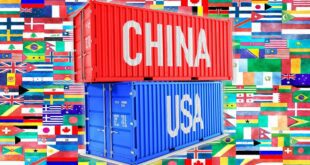Though the stock, bond and currency markets, at the moment, are preoccupied with the question of when the first interest-rate increase will happen, the real story lies in where interest rates are ultimately headed because that answer defines where stock, bond and currency prices are ultimately headed and the reality, dear reader, is that the Fed simply cannot — and will not — allow interest rates to crawl very high. [Why is that you ask? Read on!]
the question of when the first interest-rate increase will happen, the real story lies in where interest rates are ultimately headed because that answer defines where stock, bond and currency prices are ultimately headed and the reality, dear reader, is that the Fed simply cannot — and will not — allow interest rates to crawl very high. [Why is that you ask? Read on!]
The above introductory comments are edited excerpts from an article* by Jeff D. Opdyke (thesovereigninvestor.com) entitled Inflation, Interest Rates, and Why You Should Own Gold.
The following article is presented by Lorimer Wilson, editor of www.munKNEE.com (Your Key to Making Money!), www.FinancialArticleSummariesToday.com (A site for sore eyes and inquisitive minds) and the FREE Market Intelligence Report newsletter (register here; sample here). This paragraph must be included in any article re-posting to avoid copyright infringement.
Opdyke goes on to say in further edited excerpts;
The Fed simply cannot — and will not — allow interest rates to crawl very high because it knows that with every tick up, higher and higher interest rates will increasingly crimp Washington’s style and that “style,” of course, is D.C.’s penchant for wanting to splurge big on buying votes by spending stupid amounts of money on stupid programs and this has put D.C. in a bit of a bind, as you likely already know.
For more than half a century, the goobers we’ve elected to Congress have been spending our tax dollars as though they won’t live to see tomorrow and, so, what the hell: “Let’s live for today!” Now we have that $17 trillion in public debt that you always read about — and the $120 trillion in unfunded debt on and off America’s balance sheet that you don’t always read about but that is, nevertheless, all too real and, because of that, rising interest rates pose a significant challenge for the Fed and for Congress.
Consider some numbers and you will quickly understand the problem we face as a first-world nation rapidly moving toward Banana Republic status:
In 2013, America’s interest payments cost U.S. taxpayers $415.7 billion. Some commentators I’ve read have used that as proof that we’re finally getting our debt under control because
- in 2007, interest payments were higher, at $430 billion but,
- in 2007, total debt was just $9 trillion vs. $16.7 trillion at the end of 2013 and
- in 2007, the average annual interest rate across all maturities of Treasury debt was 4.94% vs. just 2.02% in 2013 so
- in 2013, we had a much larger sum of debt, but benefited from exceedingly low interest rates.
The Congressional Budget Office calculates that if interest rates move back toward norms by 2020 — meaning 10-year notes at 5% (they’re 2.4% today) and 3-month T-bills at 3.7% (they are 0.03% today) — our annual debt payments will explode to more than $840 billion, double what we’re paying now – and that implies:
- a vicious debt-cycle in which the U.S. government must issue more debt to make debt payments, which then leads to more debt as the debt payments rise because of all the new debt needed to repay the existing debt and
- a dramatic change to America’s tax-rate structure. The wealthy class now responsible for 39% of all federal taxes, will be forced to dig even deeper into their wallets.
- a shrinking of the lifestyle of the middle-class, now responsible for just 3% of all Federal taxes paid, as more taxes come out of their paychecks,
- a sudden sting of Uncle Sam’s pick-pocketing ways by the lower-middle-class, that now earns money from the federal tax system, as their tax benefits become tax obligations.
In short, America’s consumer-dependent economy would:
- see said consumers lose a meaningful portion of their spending power to government taxation and, worse, would
- see the increased taxes paid out flow to holders of U.S. debt, many of whom live overseas, as opposed to turning around and flowing back into the economy. We would, in essence, be working our butts off so that a debt-drunk Uncle Sam could send ever-larger sums of our tax dollars to the Chinese, the Japanese, the Russians, the Brits, the Taiwanese and others.
Ultimately, the above would be a political, social and financial disaster for Washington, D.C. and the Fed is smart enough to realize these ramifications exist.
This brings us back to the main point: the Fed’s ultimate destination with interest rates. My guess is that the Fed-funds rate, the Federal Reserve’s key interest-rate lever,
- will not go higher than 2% and, more important,
- getting there will take years, not months. The Fed will not raise rates in rote 0.25% step-ups over a few meetings. It might move in 0.1% increments, and it could go several months or maybe even a year between rate hikes.
In short, we’ve been stuck at near-0% interest rates for more than five years and it very well could take the Fed another five years or more to get us back toward 2%, simply because it knows that Congress has worked itself into an impossible financial situation.
Interest Rates, Inflation & the Future Price of Gold
The knock on gold is that it pays no rate of return and is, therefore, not a smart asset to own when money in the bank or in Treasury paper offers a decent yield but, when rates begin to rise, money in the bank or in Treasury paper will still offer no real yield in the future, given that inflation has begun to move up as wages now rise (a little jab to the gut from all those efforts to push minimum wages higher). That means inflation will equal or outpace the interest rates you’ll be able to earn in savings accounts, CDs and government bonds – and that is the environment that is brightest for gold. When you’re losing purchasing power just by letting your money sit in savings, CDs and bonds, gold is a godsend. Its price tends to rise in such an environmentso, do yourself a favor:
- Do not look at the coming Fed rate-hike cycle as an opportunity, finally, to move some cash back into CDs and savings account.
- Look at it for what it really is: An opportunity to grab gold now, at a fair price, knowing that the Fed has no other option but to keep interest rates exceedingly low for a long, long — long — time.
Until next time, stay Sovereign …

Jeff D. Opdyke
*http://thesovereigninvestor.com/gold/inflation-interest-rates-why-you-should-own-gold/ (By Jeff D. Opdyke; ©The Sovereign Investor Daily®, Copyright 2014; Subscribe here.)
Editor’s Note: The author’s views and conclusions in the above article are unaltered and no personal comments have been included to maintain the integrity of the original post. Furthermore, the views, conclusions and any recommendations offered in this article are not to be construed as an endorsement of such by the editor.
If you liked this article then “Follow the munKNEE” & get each new post via
- Our Newsletter (sample here)
- Twitter (#munknee)
Related Articles:
1. What Do Current Low Interest Rates Mean For the Future Price of Gold?
Investors commonly assume that rising interest rates adversely impact the gold price, and vise versa. They believe that a rising interest rate environment is indicative of a strong economy, which is supposed to drive investors out of gold and into the stock market. They further assume that investors will want to exchange their gold, which has no yield, for stocks and bonds, both of which have yields and generate income but this intuition is unfounded. Let me explain why that is the case ans why, as such, gold investors shouldn’t fear rising interest rates. Read More »
2. Interest Rates Play A MAJOR Role In the Behavior Of the Stock Market – Here’s Why
To understand how the stock market behaves it is imperative to realize that the stock market is overwhelmingly influenced by interest rates. It’s difficult to overstate this key fact. Interest rates are the bone and marrow of the stock market. More specifically, the stock market is ruled by long-term and short-term interest rates creating an overriding framework for what drives the market in which different sectors do better or worse at different points in the economic cycle. This article explains the behavior more fully. Read More »
3. Will Higher Interest Rates Result From Additional Tapering?
After a long period of very low interest rates following the global financial crisis the central banks of the U.S. and U.K. are planning to gradually tighten their easy monetary policies as their economies improve. When their benchmark interest rates go up, interest rates elsewhere will go up to so should we worry if and when global financial conditions tighten? Read More »
4. We’re Doomed! Rising Interest Rates Will Cause Our Financial System To Implode
We’re doomed! Even if the economy were growing at a faster pace, it wouldn’t come close to offsetting the interest payments on our ever-expanding debt. As such, any sort of credit shock – either rising rates or a decline in the rate of debt expansion – will cause the system to implode. Let me explain why that is the case. Read More »
5. Interest Rates to Remain Low As Far As the Eye Can See? Perhaps, BUT
Everyone knows that interest rates are going to rise in the future so the real question is not whether they will rise, but when and by how much. [This article analyzes when that will most likely be.] Read More »
6. Higher Interest Rates Will Come Once These 4 Economic Conditions Are Met
4 economic conditions need to be in place for interest rates to rise ahead of – and independent of – the Fed’s forward guidance. The economy met only one of those conditions to date but will likely meet all four by the end of the year…What follows is a status report on the four conditions. Read More »
7. Interest Rates NOT Rising Any Time Soon – Even With Fed Tapering. Here’s Why
Everyone and their mom is expecting long-term interest rates to rise now that the Fed is tapering its bond buying programs. I have a couple of problems with this line of thinking because, although it seems like reducing demand for a security (i.e. tapering QE) would result in a drop in price, when you really think about how quantitative easing works this makes no sense and, secondly, the market is telling us this makes no sense. Let me explain. Read More »
8. Rapid Rise In Interest Rates Will Collapse U.S. Financial System – Here’s Why
There is one vitally important number that everyone needs to be watching right now, and it doesn’t have anything to do with unemployment, inflation or housing. If this number gets too high, it will collapse the entire U.S. financial system. The number that I am talking about is the yield on 10 year U.S. Treasuries. Here’s why. Words: 1161; Charts: 2 Read More »
9. Variable Interest Rates: Staring Into the Abyss
It seems that the past few years of falling interest rates have lulled a big part of the global economy into financing with variable-rate debt…[As such,] when interest rates go up (as they did last week), there’s a world-wide reset in interest costs that, best case, amounts to a tax increase on individuals and businesses and, worst-case, threatens to blow up the whole system. Read More »
10. Bonds Getting Slaughtered, Interest Rates to Rise Dramatically, Economic Bubbles to Implode
What does it look like when a 30 year bull market ends abruptly? What happens when bond yields start doing things that they haven’t done in 50 years? If your answer to those questions involves the word “slaughter”, you are probably on the right track. Right now, bonds are being absolutely slaughtered, and this is only just the beginning. So why should the average American care about this? Read More »
11. Rapidly Rising Interest Rates Could Lead to Financial Collapse – Here’s Why
The global financial system is potentially heading for massive amounts of trouble if interest rates continue to soar. So what does all this mean exactly? [Let me explain.] Read More »
12. Rising Interest Rates Could Plunge Financial System Into a Crisis Worse Than 2008 – Here’s Why
If yields on U.S. Treasury bonds keep rising, things are going to get very messy. What we are ultimately looking at is a sell-off very similar to 2008, only this time we will have to deal with rising interest rates at the same time. The conditions for a “perfect storm” are rapidly developing, and if something is not done we could eventually have a credit crunch unlike anything that we have ever seen before in modern times. Let me explain. Read More »
13. A Rise in Interest Rates Would Derail An Economic Recovery – Yes or No?
[While]… I am not currently predicting an acceleration in inflation [I believe]…that the risk of interest rate instability is very real [given that] core inflation is already above a key benchmark that the Fed has staked its credibility on,. It should be of concern to investors that, despite economic growth being so anemic and overall resource utilization being so low (including human resources), there is currently very little margin for error on the inflation front. [In this article the author evaluates the danger that rising interest rates could potentially have on the U.S. economy.] Words: 2050 Read More »14. Negative Interest Rates Becoming More Prevalent – Here’s Why You Should Be Concerned
The once unthinkable might become policy: negative nominal interest rates. Investors should care as they may be increasingly punished for not taking risks yet masochistic investors believe they may be the prudent ones given the risks lurking in the markets. What are investors to do, and what are the implications for the U.S. dollar and currencies? Words: 779 Read More »
15. Current Distortion of Interest Rates is Unsustainable & Will Have Dire Consequences
Interest rates have been manipulated to keep them extremely low in an attempt to stimulate the economy but…unless deficits are dramatically reduced…. interest rates will eventually rise and government interest expense will double or triple from the amounts being paid today. That potentially triggers a debt death spiral, where government has to borrow more than otherwise expected. It also raises the credit risk and could ratchet interest rates up again. It has happened to Greece, Portugal, Spain and other European countries already this year and could well happen in the U.S. too. Words: 595 Read More »
16. Eventual Rise in Interest Rates Will Be Downfall of U.S. – Here’s Why
Everyone who purchases a Treasury bond is purchasing a depreciating asset. Moreover, the capital risk of investing in Treasuries is very high. The low interest rate means that the price paid for the bond is very high. A rise in interest rates, which must come sooner or later, will collapse the price of the bonds and inflict capital losses on bond holders, both domestic and foreign. The question is: when is sooner or later? The purpose of this article is to examine that question. Words: 2600 Read More »
17. Niall Ferguson: U.S. Playing “Russian Roulette” Assuming Interest Rates Will Remain Low
Countering Krugman’s argument that today’s low interest rates show that no one is worried about lending money to us and, therefore, that we should borrow and spend our way to prosperity, Ferguson argues that today’s interest rates are irrelevant. When countries get into trouble, he says, they get into trouble quickly – the way Greece and other European countries have. Taking … Read More »
18. U.S. Financial System Will Die When Interest Rates Rise! Here’s Why
Right now, interest rates are near historic lows. The U.S. government is able to borrow gigantic mountains of money for next to nothing. U.S. consumers are still able to get home loans, car loans and student loans at ridiculously low interest rates. When this low interest rate environment changes (and it will), it is going to absolutely devastate the U.S. economy. Without low interest rates, the U.S. financial system dies. [Let me explain.] Words: 1529 Read More »
19. Five BIG Reasons Interest Rates MUST Rise
Brace yourself for one of the greatest interest-rate surges in decades — beginning first in the long-term Treasury markets … later spreading to shorter term Treasuries … and ultimately enveloping nearly every loan, debt, credit, and money market instrument on the planet. This rise may not begin with great fanfare, nor will it immediately upset the apple cart of the economic recovery, but with the march of time, it WILL gain momentum and reach critical mass. Words: 614 Read More »
 munKNEE.com Your Key to Making Money
munKNEE.com Your Key to Making Money


